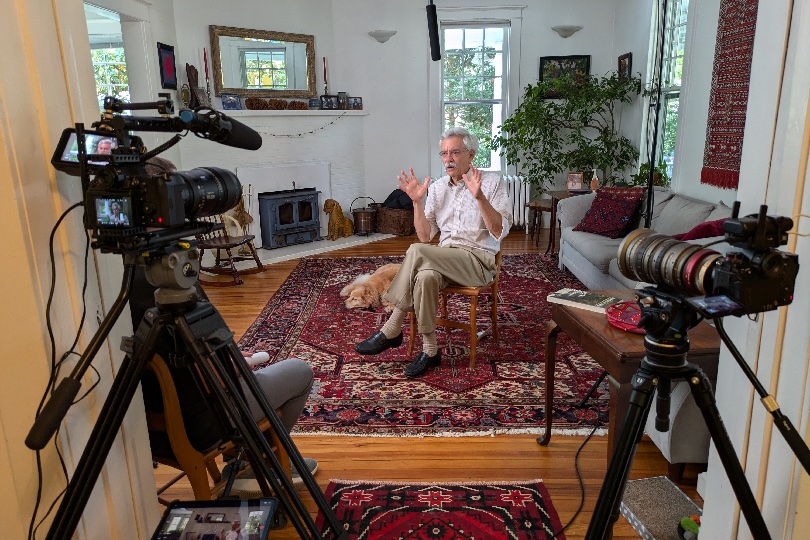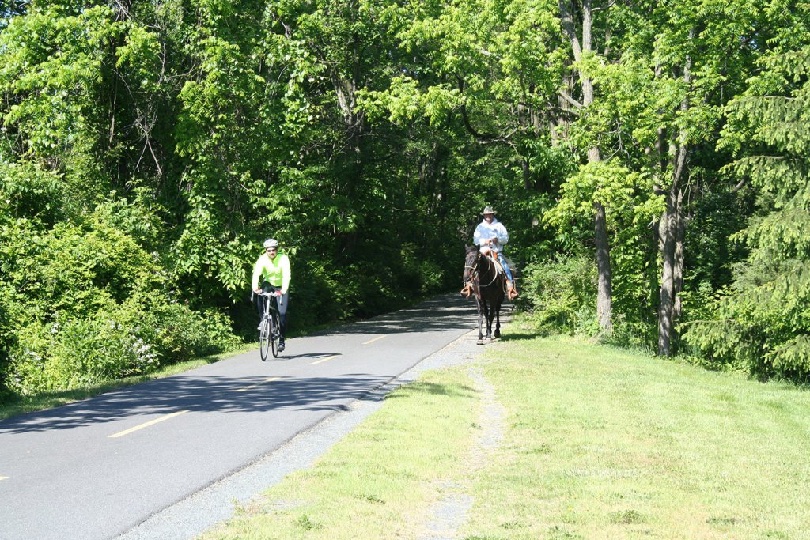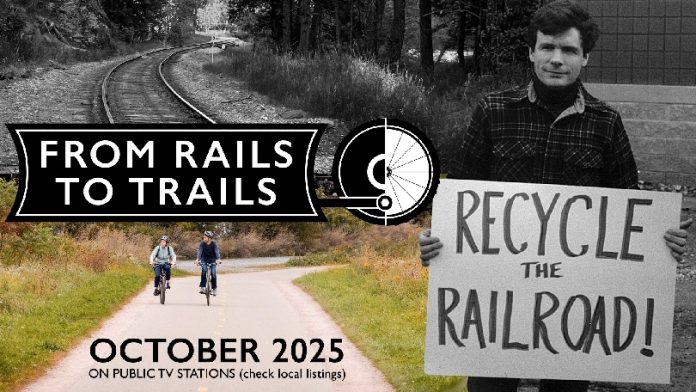Running 45 miles from Shirlington to Purcellville, the Washington & Old Dominion Trail is popular with dog walkers, stroller pushers, cyclists and joggers. But did you know that from 1859-1968 it was an oft-traveled railroad? Three times a day, trains would travel its tracks from Alexandria to Falls Church, Leesburg and Purcellville, with stops at Dunn Loring, Hunter Station and Paeonian Springs.
“So many people…come up to me and say, ‘I’ve been on my favorite trail for years and I never knew it was a railroad,'” says Arlingtonian Peter Harnik, an expert on trails made from abandoned railroad corridors. He’s hoping to educate more Americans about this growing form of adaptive reuse with From Rails to Trails, a new PBS documentary for which he served as executive producer. Narrated by Academy Award-nominated actor Edward Norton, the one-hour special will stream on PBS.org starting Oct. 15 and will air on WETA Metro on Oct. 18, 8 p.m.

Recycling Rails
The film, based on Harnik’s 2021 book by the same name, explores the 60-year rails-to-trails movement. The practice originated in the 1960s, when rail companies abandoned nearly 50,000 miles of track nationwide as automobiles replaced trains as Americans’ preferred mode of transportation. Wisconsin’s Elroy-Sparta State Trail became the first rail trail when it opened to the public in 1967.
Virginia’s New River Trail State Park in Max Meadows became the first official rail trail in the Commonwealth when it debuted in 1976, although the first segment of the W&OD had already opened in Falls Church two years earlier. Today, Virginia is home to 52 rail trails, according to the Rails to Trails Conservancy, which Harnik co-founded in 1986.
“I came to that through bicycling,” says the Manhattan native. “Growing up in New York, it was never a car-free place to bike, and I love to bike. When they closed Central Park to cars, I thought that was a real revelation.”

Harnik began pushing for parks, including D.C.’s Rock Creek, to close to vehicle traffic, but found it a tough sell. “When I came across the concept of converting abandoned railroad lines [in the 1980s], I realized that no cars had ever been on these tracks before, and maybe that would be easier than trying to create a situation where you’re pushing cars out of something they’re used to using,” he says.
W&OD’s Storied History
To date, Harnik has traveled more than 200 rail trails across the country. The W&OD counts among his favorites, he says, and as a local, he hits it two to three times a week. “It’s a fabulous trail in terms of avoiding the way overbuilt, scary, annoying, dangerous traffic in Northern Virginia,” he says. Plus, “knowing these railroads were involved with the Civil War,” adds another dimension of historic intrigue.
Known back then as the Alexandria, Loudoun and Hampshire Railroad, the W&OD “was the site of a few skirmishes during the Civil War,” according to the Northern Virginia Regional Park Authority (NOVA Parks). When the rail line stopped operating in 1968, the predecessor to what’s now Dominion Energy bought the right-of-way for its electric power transmission lines. In 1977, NOVA Parks acquired the use of the railroad right-of-way and began rebuilding it as a trail for cyclists and pedestrians.
Harnik and late Rails to Trails Conservancy co-founder David Burwell used the W&OD to successfully lobby Congress to appropriate funds in support of rail trail development. (Burwell died in 2017.) The Intermodal Surface Transportation Efficiency Act of 1991 was the first to make funding available for the effort.
The Case for Rail Trails
Several factors make former railroads ideal for trails. A big one is that such conversions are relatively low in cost. The railroad companies have already charted the path, bridged over streams and cut tunnels. “The railroads have already spent millions of dollars—the kind of money that today’s departments of transportation or department of parks would never spend,” Harnik says.
In general, communities tend to support the trail redevelopment. Such projects provide easy access to nature—”the air smells great, you see animals, you see beautiful trees,” Harnik says—and some small towns build tourism around them. “People can stop for everything from just an ice cream to a full-fledged bed-and-breakfast,” he adds.
“In highly urban areas, like the Capital Crescent [trail] in D.C. or the Metropolitan Branch Trail in D.C., it’s [about] finding a safe place to ride, getting away from traffic and just having a really nice…commute,” he says. (Both of those trails follow parts of the former Baltimore and Ohio Railroad.)
What Opponents Say
Not everyone is is pro-rail trails, however. Community members who oppose them typically do so for two reasons, Harnik says. Some worry the increased traffic on reopened trails will draw crime to their neighborhoods. Others have concerns over property ownership and economic development.
“That’s why we had to create the Rails to Trails Conservancy,” Harnik says. There were lessons to be learned from the roadblocks proponents encountered in the ’80s when the movement was just getting started. “But 99% of the time, when a trail goes through…everybody loves it and uses it. The people who were against it say, ‘This is the best thing that’s happened to our community.'”
Chugging Along
Looking for a scenic rail-trail bike ride? Harnik recommends taking the W&OD to White’s Ferry near Leesburg out and back. “That’s a fun ride,” he says.
Meanwhile, the conservancy says there are more than 9,000 miles of potential rail trails nationwide, including 118 in Virginia. “Hopefully this documentary on TV will help stimulate people to look for tracks and convert them,” he says.
